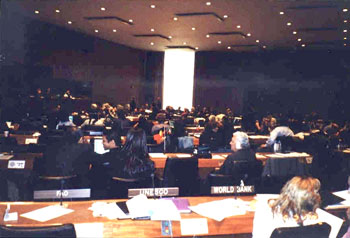| |
United Nations, New York: May 23, 2002

Dear Mr. Chairperson, distinguished members and honorable
participants,
My name is Enhebatu Togochog and I am an indigenous Mongolian
from the Chinese Communist Party controlled Southern Mongolia.
I am pleased to make a statement on behalf of the Southern
Mongolian Human Rights Information Center ( SMHRIC ).
Southern Mongolia, better known as Inner Mongolia, the native
land of 4.5 million indigenous Mongolian people, has been
occupied by the Chinese Communist Party since 1947. During
the half century’s series of massacre, crack-down, cultural
assimilation and Han Chinese immigration policies by the Chinese
Communist Party, indigenous Mongols in this area have experienced
their darkest history: at least 700,000 indigenous Mongols
were killed, maimed, tortured, sent to jail, arrested and
detained; 3,000 Buddhist temples were completely destroyed
by the CCP during the Cultural Revolution; since 1980’s,
a series of indigenous Mongolian student’s peaceful movements
have been harshly cracked down and hundreds of thousands of
indigenous Mongolian dissidents have been arrested and sent
to long term jail; ethnic Mongolians’ native land and
natural resources have forever been occupied by the Han Chinese;
large-scale of Han Chinese immigrations to the area not only
made indigenous Mongols as minority in their own land but
also gave a total destruction to the Inner Mongolian ecological
system.
Southern Mongolian grassland was known as one of the most
well-preserved natural grassland in the world. However, after
the intensifying cultivation and random exploitation by the
Han Chinese, 81% of the whole territory in Inner Mongolia
became desert and soil erosion areas, and most of the grassland
are vanished from the earth. While the sandstorm from Southern
Mongolian desert is blotting out the sky and the land in Beijing,
the Central Government has adopted a new policy against indigenous
Mongolian herders in Southern Mongolia under the pretext of
“giving rest to the grassland and recovering the eco-system”.
This policy is called “ Environmental Immigration”
( Sheng Tai Yi Min in Chinese ), aiming at a total relocation
against the entire population of indigenous Mongolian herders
from their native land to the overwhelmingly Han Chinese populated
agricultural and urban areas. According to the Chinese official
news, since 2000, at least 160,000 indigenous Mongolian herders
have been forcefully relocated from their pasture land and
their traditional nomadic life-style has forever been altered.
Various first-hand information from Inner Mongolia show that
the so-called “ Environmental Immigration” is not
only a cultural genocide but also a gross human rights violation
against indigenous Mongolian people. Thousands of millions
of Mongolian herders have lost their houses, livestock, lands
and been treated brutally by the authorities during the relocation
process. The Mongols in the region are now experiencing a
“ Trail of Tears” as the Native Americans had experienced
centuries ago!
Mr. Chairman, I urge the Permanent Forum to pay a close attention
to this ongoing mass forced displacement against indigenous
Mongolian people in Southern Mongolia. I also would like to
ask the Permanent Forum and other human rights bodies to give
an effective pressure on the Chinese government to stop this
human rights gross violation in Southern Mongolia.
Thank you!
Enhebatu Togochog
|





